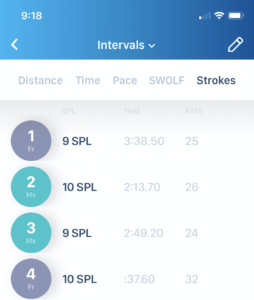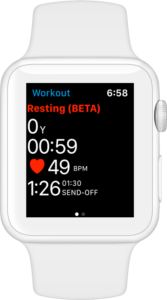Swimming is a complex sport – it requires not only a tremendous amount of physical effort but also a constant cognitive involvement. This continuous attention to detail can sometimes take us away from the physical excursion and get our minds in a jumbled mess.
With the abundance of information available in our sport, it can seem like definitions, drills and data are being thrown at you from all different directions. This can sometimes leave us more confused than informed. At Swim.com we are aiming to simplify all this information and deliver it to you in ways we can all understand and apply.
Here are some basic terms you should include in your daily swimming routine:
Stroke Cycles Per Length (SPL): This term is probably the most simple to digest. Stroke cycles, which is the combined amount of right and left arm strokes taken over a length. For example, if you took 12 strokes per length, you took six stroke cycles. Swim.com’s algorithm counts your stroke cycles by tracking the arm that wields your smartwatch. To view your stroke count from any completed swim in the app, tap View Swim > View Swim Details and from there you can select your Distance, Time, Pace, SWOLF and Strokes.
 Stroke Rate: This term is often confused with “tempo” as they are synonymous. Swim.com measures stroke rate as the amount of strokes per minute. This number can be found on the right-most column in the Swim Details section of the app.
Stroke Rate: This term is often confused with “tempo” as they are synonymous. Swim.com measures stroke rate as the amount of strokes per minute. This number can be found on the right-most column in the Swim Details section of the app.
SWOLF: This term is an abbreviated term for “swim golf” and, like the sport of golf, the lower your SWOLF score, the better. The mathematics of it are rather simple, with just a simple addition of your stroke count and your lap time. So if you swam a 25 in 20 seconds and took 15 strokes, your SWOLF score for that 25 would be 35. The SWOLF score is not indicative of your ability to swim fast or be efficient in the water. It can, however, be useful in detecting areas where you can lengthen out your stroke and be smoother, to go further, faster, with less effort. Your SWOLF score can be found in the Swim Details section.
Pace: In swimming, pace is expressed as time per 100 yards or meters. For example if you swim 50 yards in 45 seconds, then your pace is 90 seconds per 100.
Send-off: In the Swim.com Workouts library you will often come across an interval that looks like this: 4 x 100y @ 1:30. This means you are swimming four 100s with each interval (after the first one) starting 90 seconds after
interval that looks like this: 4 x 100y @ 1:30. This means you are swimming four 100s with each interval (after the first one) starting 90 seconds after
the previous interval. For example, let’s say you finish the first interval in 1:25. You would then have 5 seconds of rest before starting your next interval. In the Swim.com apps (for Apple Watch, WearOS and Samsung), we have a feature called Pace Mode to support intervals based on a send-off time.
Build: This term is used by swim coaches of all disciplines across all sports including marathon swimming, pool swimming and triathlon. Build essentially asks you to increase your effort over a designated length.
- An example of a build set might be:
- 4×50 @ 1:00, build to full speed. This set is asking you to go four 50’s, getting faster as you go through each individual 50. If done correctly, build distances have the same swimming time.
- So, say you’re swimming in a 25 yard pool for this set – if you start out at 75% effort for the first 12.5, the next 12.5 would be at 80% effort, then 85% effort for the next 12.5 and for the final 12.5 you’d be at 90+% effort.
Descend: Often confused with “build” because of their similar nature. Descend differs from build in that you are asked to increase your effort over a longer period and across several repetitions.
- An example descend set would be:
- 4×100 @ 1:30 Descend 1-4. This set asks you to go faster on each 100, meaning #2 is faster than the first 100, #3 is fast than #2 and the final 100 is as fast as possible
Look for terms like build and descend in our curated workouts.
 Drill: a term that should be used everyday. Drilling is a perfect way to slow down what you’re doing and hone in on one or two specific aspects of your stroke. Coaches use drills to help athletes focus on the weakest parts of their stroke, to help develop a more well-rounded, balanced swimmer. Our Swim.com app has a Drill Mode specifically designed to allow you to focus on your technique. While in Drill Mode the app will count your laps while turning the clock off so you can turn your mind on.
Drill: a term that should be used everyday. Drilling is a perfect way to slow down what you’re doing and hone in on one or two specific aspects of your stroke. Coaches use drills to help athletes focus on the weakest parts of their stroke, to help develop a more well-rounded, balanced swimmer. Our Swim.com app has a Drill Mode specifically designed to allow you to focus on your technique. While in Drill Mode the app will count your laps while turning the clock off so you can turn your mind on.
Stay tuned for more in-depth blogs on each of these (and more!) swimming terms. Next week we’ll present a ton of great drills to help you become a stronger, more efficient swimmer.
Until then, get out there and #leadyourlane!
This is very helpful for a new swimmer (like me.) Thank you
Glad we can help you, Anthony! Thanks for the comment 😃
Some of this is confusing.
In SPL you say “if you took 12 strokes per length, you took six stroke cycles”. That’s true for front crawl and back crawl but incorrect for fly and breast where you would have taken 12 stroke cycles.
In Stroke Rate you say there is confusion with tempo because they are synonymous. If they are synonymous then that is not confusion, that is understanding.
Toby,
Thanks for the comment! You’re right in saying 12 strokes for breast and fly is the same as 12 stroke cycles for those two strokes. We are referring to free and back in the article.
Stroke Rate and Tempo are often used in describing the same thing; the time it takes you to complete a stroke cycle. Some find the use of two different words to be confusing when they actually mean the same.
Thanks for using Swim.com!
Is it possible to chart these variables over time? Ie, can I generate a line graph with the app which displays my SWOLF over the last year?
Not today but we have been thinking more about extending our graphing and reporting abilities and this is on the list!